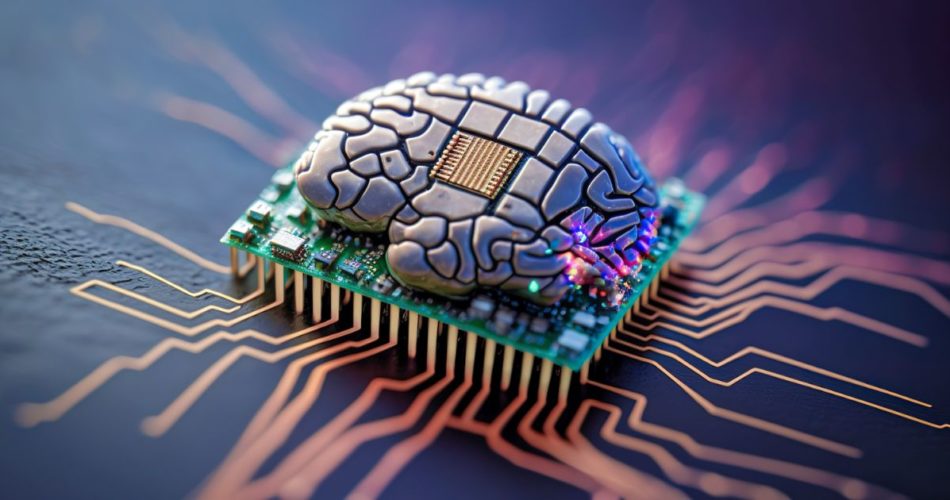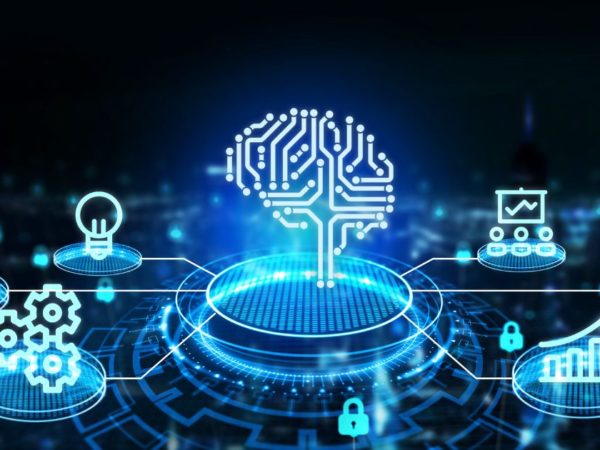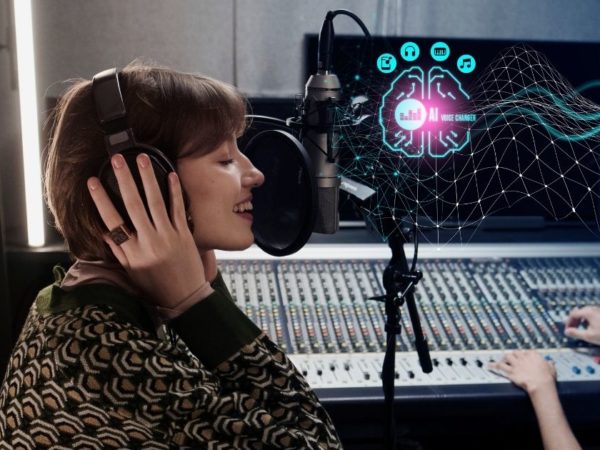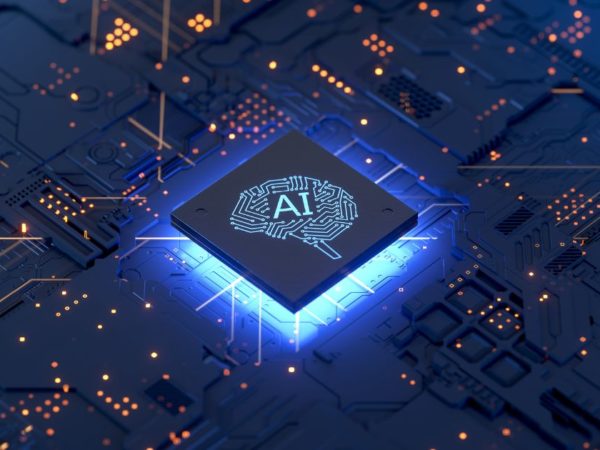<img alt="Neuromorphic Computing Explained" data- data-src="https://kirelos.com/wp-content/uploads/2023/09/echo/Neuromorphic-Computing-Explained.jpg/w=800" data- decoding="async" height="420" src="data:image/svg xml,” width=”800″>
Here, you’ll learn the technology and everything else behind neuromorphic computing, which will soon transform how you create things using computers!
The workloads of computers are ever-increasing with the growth of advanced technology like artificial intelligence (AI), machine learning (ML), the Internet of Things (IoT), AI robots, automated production lines, and a lot more.
The present-day computers working with semiconductor chips have reached their capability to process calculations faster, consume less energy, dissipate heat efficiently, and finally, their ability to become much smaller than handheld devices.
Here comes neuromorphic computing! This technology allows computer scientists and neuromorphic engineers to make computers that function like human brains. Keep reading until the end to learn all you need to know about this cutting-edge computing technology!
What Is Neuromorphic Computing?
<img alt="YouTube video" data-pin-nopin="true" data-src="https://kirelos.com/wp-content/uploads/2023/09/echo/maxresdefault.jpg6507f38a63cc1.jpg" height="720" nopin="nopin" src="data:image/svg xml,” width=”1280″>
Neuromorphic computing is a computer architecture that resembles how the human brain functions. Specifically, computer scientists are working to create prototypes of synthetic neurons that mimic biological neurons and their synapses.
The human brain uses 86 billion neurons in a compact space of 1260 cubic centimeters. The synaptic connectivity between these neurons controls memory, vision, reasoning, logical thinking, motor movements, and many more functions of the body. Of course, we don’t need any external cooling system to cool the processing units of the brain because it’s highly energy efficient.
Thus, real neuromorphic computers will function just like the human brain but using artificial synaptic devices, CPUs, and GPUs. Also, these computers will be able to adapt to the situation and not fully rely on pre-programming, which most super and personal computers do.
For example, the Intel Loihi 2 is the second-generation neuromorphic research chip. It contains about 1 million synthetic neurons per chip, mimicking the biological brain system in computing systems. It’s operated by the Lava software framework, which is an open-source operating system for neuromorphic computation research and development.
Neuromorphic Engineering
It’s the field of endeavor where computer scientists learn and design computer parts for the purpose of neuromorphic computing, like neuromorphic chips, artificial synaptic devices, energy efficiency strategies, and more.
In this technological research and development discipline, engineers will also work on neuromorphic sensors mimicking sensory systems in humans, like eyes, skin, nerve impulses, etc.
Neuromorphic Computing: Key Principles and Concepts
- Biomimicry emulates the structure and function of the human brain’s neural networks.
- Spiking Neurons are artificial neurons that communicate via spikes or pulses of activity.
- Parallel Processing enables simultaneous data processing, akin to the brain’s parallel information handling.
- Event-driven processing focuses on relevant data changes, conserving energy by avoiding constant computation.
- Synaptic Plasticity facilitates the adaptive connections between artificial neurons for learning and memory.
- Low power consumption strategy prioritizes energy efficiency, making it suitable for mobile and edge computing.
- Real-time processing is ideal for applications requiring rapid decision-making, such as robotics and autonomous systems.
- Neuromorphic hardware is a specialized hardware architecture that optimizes neuromorphic computing tasks.
- Cognitive computing aims to develop systems capable of cognitive functions, like perception and decision-making.
- There’s an interdisciplinary approach that combines neuroscience, computer science, and engineering to advance neuromorphic computation systems.
Now, we will discuss how neuromorphic computing works.
How Does Neuromorphic Computing Work?
Neuromorphic computing employs hardware components inspired by the structures and functions of neurons and synapses in biological brains. The primary type of neuromorphic hardware is the spiking neural network (SNN), where nodes, known as spiking neurons, manage and store data much like biological neurons.
Artificial synaptic devices establish connections among spiking neurons. These devices employ analog circuitry to transmit electrical signals resembling brain signals. Unlike conventional computers that use binary encoding, spiking neurons directly gauge and encode discrete analog signal alterations.
Hardware Components of Neuromorphic Computing
#1. Spiking Neurons & Synaptic Devices
Synthetic neurons process and transmit data using spike-like electrical signals. These are connected with synaptic devices.
Synaptic devices replicate the synapses in biological brains. Synaptic devices enable communication between spiking neurons.
#2. Analog Circuitry
These circuits handle electrical signals in an analog technique that mimics brain signals.
#3. Memristors
These non-volatile resistors can store and process information commonly used in neuromorphic hardware.
#4. Neuromorphic Chips
Neuromorphic Chips are specialized integrated circuits designed for neuromorphic computing tasks. These are filamentary-oxide-based resistive memory technology (OxRAM)-based computer chips.
#5. Neural Cores
These are processing units dedicated to running neural network simulations and computations.
#6. Event-Driven Sensors
These advanced sensors detect changes in data and trigger neural responses, optimizing power efficiency. For example, Event-based Vision Sensors (EVS) can transmit data faster at low latencies by analyzing the illumination changes in pixels.
#7. Memory Units
Storage components for retaining information and facilitating learning in neuromorphic systems.
#8. Neuromorphic Hardware Platforms
Comprehensive systems designed to support and execute neuromorphic computing applications.
#9. Digital-to-Analog Converters
DACs convert digital data into analog signals for neural processing.
Software Components of Neuromorphic Computing
#1. Neural Network Simulators
These are programs that emulate the behavior of spiking neural networks. These specialized tools enable testing and experimentation on neuromorphic computers.
#2. Neuromorphic Software Frameworks
Advanced software that facilitates the development and simulation of neuromorphic models and algorithms for neuromorphic computing.
#3. Learning Algorithms
These software routines enable artificial neural networks to adapt and improve their performance over time through training.
#4. Neuromorphic Programming Libraries
A set of collections of pre-written code and functions for simplifying the development of neuromorphic applications.
#5. Neuromorphic Vision Software
Software designed for processing visual data in neuromorphic vision systems, such as event-based cameras.
#6. Neuromorphic Emulators
These specialized tools allow developers to simulate the behavior of neuromorphic hardware on conventional computer systems for testing and debugging.
#7. User Interface Software
GUIs or CLIs facilitate the communication between neuromorphic hardware and higher-level computing systems. The tools further facilitate integration into broader applications.
#8. Neuromorphic Software Development Kits
These are comprehensive SDK packages that provide tools, libraries, and documentation for building neuromorphic apps.
Use Cases for Neuromorphic Computing
<img alt="YouTube video" data-pin-nopin="true" data-src="https://kirelos.com/wp-content/uploads/2023/09/echo/maxresdefault.jpg6507f38ab81b2.jpg" height="720" nopin="nopin" src="data:image/svg xml,” width=”1280″>
Autonomous Vehicles
Neuromorphic hardware and algorithms can help self-driving cars make real-time decisions. This will further improve safety and navigation in complex traffic scenarios.
Image Recognition
Neuromorphic computing can enhance image recognition by enabling efficient processing of visual data. In applications like real-time facial recognition and object detection, this could be a huge leap.
Natural Language Processing
It can improve speech and language understanding in AI chatbots, virtual assistants, AI data analytics tools, etc. This will further lead to more conversational and responsive interactions.
Energy-Efficient Computing
IoT and IIoT require super small-sized computers with local processing capabilities at the least possible energy supply. Neuromorphic computing technology will enable IoT hardware developers to produce more efficient and smart gadgets to control homes, offices, and industrial facilities.
Also read: IIoT vs IoT: Differences and Similarities
Cybersecurity
In cybersecurity and internet data privacy ecosystems, neuromorphic computing can aid in anomaly detection by analyzing network traffic patterns. Thereby, these systems will identify potential security threats more effectively.
Learning Resources
#1. Neural Networks in Python from Scratch: Udemy
This Udemy course on Neural Networks in Python offers you hands-on experience in neuromorphic computing and machine learning. It teaches you to program neural networks from scratch in plain Python.
The course will introduce hidden layers and activation functions to you for developing more useful networks. It also helps you understand aspects like the input layer, output layer, weights, error function, accuracy, etc.
#2. Neuromorphic Computing: Class Central
This free online course is available via YouTube, and you can access it at your convenient time. The course duration is more than half an hour.
It is divided into multiple sections, such as Machine That Works Like The Brain, The End of Turing-von Neumann Paradigm, Operational temperature range ATI VS cognitive ability (EQ), Global Energy Consumption, Computation Limits, etc.
#3. Neuromorphic Computing Principles and Organization
Reading this book, you will learn the principles and organization of neuromorphic computing. It also focuses on the building techniques of fault-tolerant scalable hardware for neural networks with learning capabilities.
Besides sharing the overview of neuromorphic computing systems, it lets you explore the basics of artificial neural networks. The book also discusses artificial neurons and evolution. Moreover, you will get to learn the implementation methods of neural networks in various approaches, such as neuron models, storage technologies, and inter-neuron communication networks.
This resource will turn out to be beneficial for those willing to develop an efficient neuromorphic system in hardware. Other themes discussed in this book are the challenges of building a spiking neural network architecture, emerging memory technologies, neuromorphic system architecture, etc.
#4. Neuromorphic Computing and Beyond: Parallel, Approximation, Near Memory, and Quantum
This book offers a comparative discussion on some new trends such as Neuromorphic, Approximate, In Memory, Parallel, and Quantum Computing that can help you overcome the limitations of Moore’s law.
This resource showcases the usage of the above-mentioned paradigms to enhance computing capability. It particularly helps the developers when they face scaling limitations due to the increase in computing power. Furthermore, this book provides a state-of-the-art overview of neuromorphic computing and essential details of other paradigms.
#5. Neuromorphic Engineering
After reading this book, you will have a complete understanding of neuromorphic engineering from the perspectives of three different categories of professionals: the scientist, the computer architect, and the algorithm designer.
It does not matter from which background you have come — it enables you to understand the concepts through various disciplines and appreciate the field. Apart from this, the resource focuses on the fundamentals of neuronal modeling, neuromorphic circuits, neural engineering frameworks, neural architectures, and event-based communication.
After reading this book, neuromorphic engineers will learn about the different aspects of cognitive intelligence.
#6. Neuromorphic Computing Systems for Industry 4.0
From this book, you will learn about the neural computing-based microchip technology field. By covering topics such as neural network protection, emotion recognition, and biometric authentication, it allows you to learn in detail about this dynamic field.
Whether you are a student, scientist, researcher, or academician, it will function as an essential resource for you.
#7. Neuromorphic Devices for Brain-inspired Computing
If you want to explore the cutting-edge neuromorphic technologies, read this book. Written by a team of expert engineers, it has a comprehensive discussion of all aspects of neuromorphic electronics.
It covers both memristic and neuromorphic devices, includes recent developments in brain-inspired computing, and explores its potential applications in neuromorphic computing and perceptual systems.
Challenges of Neuromorphic Computing
#1. Inaccuracy
While neuromorphic computers are definitely more efficient in terms of energy compared to neural hardware and GPUs, they are not more accurate than the rest.
#2. Lack of Defined Benchmarks
This field of research does not have any clearly defined benchmarks for performance and common challenge problems. Hence, assessment of the performance and efficiency of the neuromorphic computers is quite difficult.
#3. Software Limitations
The software of neuromorphic computing is still lagging behind the hardware. Researchers still use the software and algorithms intended for von Neumann hardware, which limits the results to standard approaches.
#4. Usage Difficulty
Unless you are an expert, you can not use neuromorphic computers. Moreover, experts haven’t created easy tools and languages so that anyone can use them.
Neuromorphic Computing: Ethical Considerations
While discussing neuromorphic computing, we must not ignore the ethical considerations. There is always the chance of misusing this technology. It can be used to generate fake images and videos with the intent of spreading misinformation, misleading people, and influencing public perception.
It could also be the cause of privacy concerns by the individuals. If it collects users’ data without consent or knowledge for processing huge amounts of data, it will surely raise concerns. Apart from these, neuromorphic computing could inherit biases from the training data. If that happens, neuromorphic computing can produce unfair or discriminatory results.
Future of Neuromorphic Computing
Neuromorphic computing is capable of revolutionizing how different devices communicate with each other. With its help, you can expect to have energy-efficient and brain-inspired computing in the future.
With the assistance of AI algorithms, devices will learn from each other and become more responsive to changes. As a result, network architectures will become more efficient and process data faster.
Currently, it can perform sensing and perception tasks. However, you can expect it to transform AI, robotics, and healthcare fields with faster and smarter devices. With the innovation in related sectors, you can expect hardware and software advancement in neuromorphic computing.
Next, check out our detailed article on ambient computing.



